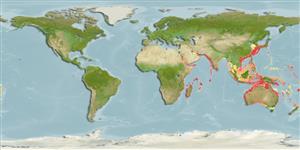Common names from other countries
Elasmobranchii (tubarões e raias) (sharks and rays) >
Carcharhiniformes (Ground sharks) >
Triakidae (Houndsharks) > Galeorhininae
Etymology: Hypogaleus: hypo (Gr.), less than, under or beneath, allusion not explained, perhaps alluding to its original position as a subgenus of Galeus. (See ETYFish); hyugaensis: -ensis, Latin suffix denoting place: Hyuga Nada, Japan, type locality. (See ETYFish).
Environment: milieu / climate zone / depth range / distribution range
Ecologia
marinhas demersal; intervalo de profundidade 40 - 230 m (Ref. 244). Deep-water; 37°N - 40°S
Indo-West Pacific: East Africa and the Persian Gulf to Taiwan and Japan. Reported from Australia (Ref. 6871).
Length at first maturity / Tamanho / Peso / Idade
Maturity: Lm ?, range 95 - ? cm
Max length : 127 cm TL macho/indeterminado; (Ref. 244); 122.0 cm TL (female)
Espinhos dorsais (total) : 0; Espinhos anais: 0. Dull grey dorsally, paler below; front part of snout slightly dusky (Ref. 5485).
Inhabits continental shelves (Ref. 244). Feeds on bony fishes and cephalopods (Ref. 6871). Viviparous (Ref. 50449). Utilized as a food fish (Ref. 244).
Viviparous (with a yolk-sac placenta), with 10 or 11 young in a litter (Ref. 244). Size of full-term fetuses about 33 to 35 cm (Ref. 244). Gestation period is estimated at 15 months (Ref. 244). Distinct pairing with embrace (Ref. 205).
Compagno, L.J.V., 1984. FAO Species Catalogue. Vol. 4. Sharks of the world. An annotated and illustrated catalogue of shark species known to date. Part 2 - Carcharhiniformes. FAO Fish. Synop. 125(4/2):251-655. Rome: FAO. (Ref. 244)
Categoria na Lista Vermelha da IUCN (Ref. 130435)
CITES (Ref. 128078)
Not Evaluated
Utilização humana
Pescarias: pouco comercial
Ferramentas
Relatórios especiais
Descarregue XML
Fontes da internet
Estimates based on models
Preferred temperature (Ref.
115969): 19.9 - 27.7, mean 23.8 (based on 194 cells).
Phylogenetic diversity index (Ref.
82804): PD
50 = 1.0000 [Uniqueness, from 0.5 = low to 2.0 = high].
Bayesian length-weight: a=0.00427 (0.00183 - 0.00992), b=3.04 (2.83 - 3.25), in cm Total Length, based on LWR estimates for this (Sub)family-body shape (Ref.
93245).
Nível Trófico (Ref.
69278): 4.2 ±0.7 se; based on diet studies.
Resiliência (Ref.
120179): Baixo, tempo mínimo de duplicação da população 4,5 - 14 anos (Fec=10; gestation about 15 months).
Fishing Vulnerability (Ref.
59153): Very high vulnerability (76 of 100).
